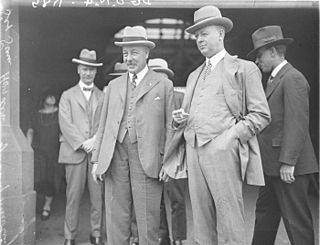
Sir Samuel Hordern was an Australian businessman, animal breeder and philanthropist. Born into the prominent Sydney trading family, Hordern directed the family company of Anthony Hordern & Sons from 1909 to 1926.

The Australian Institute of Architects, officially the Royal Australian Institute of Architects, is Australia's professional body for architects. Its members use the post-nominals FRAIA (Fellow), ARAIA and RAIA. The Institute supports 14,000 members across Australia, including 550 Australian members who are based in architectural roles across 40 countries outside Australia. SONA is the national student-membership body of the Australian Institute of Architects. EmAGN represents architectural professionals within 15 years of graduation, as part of the Australian Institute of Architects.

The Sydney County Council (SCC) was formed in 1935 to produce electricity and operate the electricity network in a number of municipalities in metropolitan Sydney. Unlike other New South Wales county councils, which were voluntary associations of local councils to undertake local government activities permitted or required of them by the Local Government Act 1919, Sydney County Council was established under a separate piece of legislation by the state government to perform the electricity distribution and streetlighting operations of the local government areas concerned. On its establishment it assumed control of the Electricity Department of the Sydney City Council, which was already supplying electricity to other municipalities. In 1952, the SCC lost most its electricity generation functions to the Electricity Commission of New South Wales and retained only its distribution functions. The SCC was merged with other municipal county councils in 1990 to form Sydney Electricity.
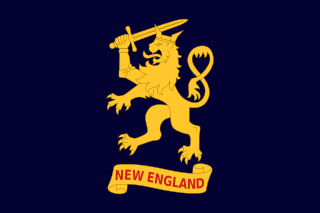
The New England New State Movement was an Australian political movement in the twentieth century. Founded as the Northern Separation Movement, the aim of the movement was to seek the secession of the New England region and surrounding areas from the State of New South Wales (NSW) and the establishment of a new State of New England. While popular at first and the subject of two Royal Commissions, the movement was unsuccessful, and was defeated at a referendum in 1967.
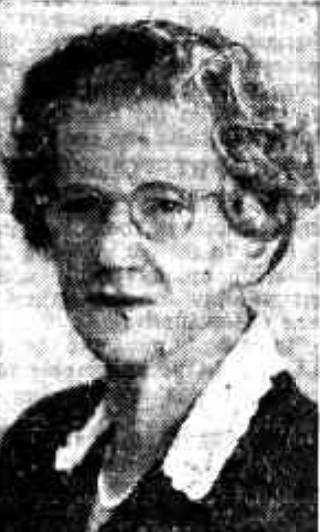
Ruth Beatrice Fairfax was a founding member of the Australian Country Women's Association and the first President of the Queensland Country Women's Association. The federal electorate of Fairfax is named in her honour.
A Blue Gum Romance is a 1913 Australian silent film directed by Franklyn Barrett. It is considered a lost film.

Will Lawson, born in Durham, England, was a popular bush poet, novelist, journalist and historian of Australia. Many of his works had sailing or stage coach themes.

Greyhound racing in Australia is a sport and gambling activity. Australia is one of several countries with a greyhound racing industry. The industry laws are governed by the State Government but the keeping of greyhounds is governed by the Local Authority.

May Gertrude Shepherd , was an Australian aviator and the first woman in Australia to hold first class pilot's 'A', 'B' and 'C' licences concurrently, in addition to a 'D' electrical ground engineers' certificate. She was also the first and the only woman in Australia, at the time, known to hold a 'X' certificate in oxy-welding and metallurgy.
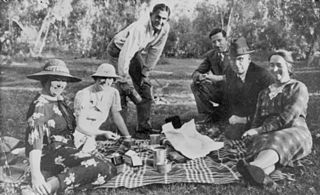
Salome Jean White was the first female flying medical doctor in Australia and the world when she commenced work with the Australian Inland Mission in May 1937. She was known as the Guardian Angel of the Gulf.
"Sleepy Seas" was a hit song which was first published 1920 by Private Reginald Stoneham while he managed the Melola Salon music store. It was an instant popular success with dance halls. The following year sales expanded to other music publishers. This vocal waltz was used to accompany silent movies, in the era before talkies.
George Smith was an Australian professional soccer player who played as a forward. He captained the Australia national soccer team in 1933. Often considered the best centre-forward in Australian soccer in the 1930s, he had an average of 2.66 goals per game for Australia and has had many goalscoring records throughout his 17-year career.
The 1948 New Zealand rugby league tour of Australia was the fourteenth tour by New Zealand's national rugby league team, and the eleventh tour to visit Australia. The eight-match tour included two Test Matches, which were the first played by New Zealand in Australia since 1909.
Captained by Pat Smith, the Kiwis returned home having won six and lost two of their games. The team won the first test match of the tour but lost the second.
The Dunlop Cup was a series of annual professional golf tournaments held in Australia from 1930 to 1952. Four separate events were held each year, in New South Wales, South Australia, Queensland and Victoria. The tournaments were sponsored by Dunlop Perdriau Rubber Co., later renamed Dunlop Rubber Australia.
William Joseph Bolger was an Australian professional golfer. He won the Australian Open in 1934, finishing three strokes ahead of Gene Sarazen. He also won the New South Wales Professional Championship twice, in 1930 and 1939 and represented Australia in the Lakes International Cup in 1934 and 1936.
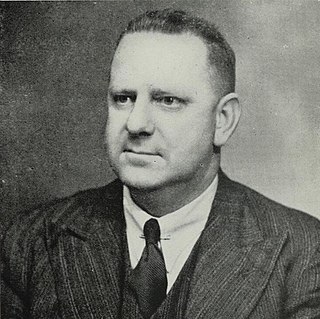
Lindsay Gordon Scott ARAIA was an Australian architect best associated for his design of the Erskineville Town Hall and numerous surf pavilions in New South Wales, including several on the Northern Beaches of Sydney.
Marie Alice Bremner was an Australian soprano, remembered for performances in Gilbert and Sullivan operas. She became a favorite performer in musical comedy, first on stage, then revivals and variety shows on broadcast radio. She was popular with producers for her ability to take on key roles at a moment's notice and draw "rave" reviews. Her accompanist husband Ewart Chapple became a senior executive with the Australian Broadcasting Commission.
Neal McCusker CBE, often misspelled "Neil", was Commissioner of Railways in New South Wales 1956–1972.
Wilfred Lemuel Jarvis was a Baptist evangelist and gospel singer in Brisbane and Sydney, Australia.










